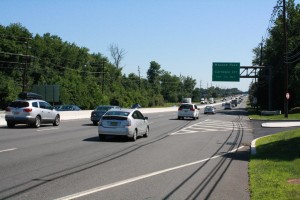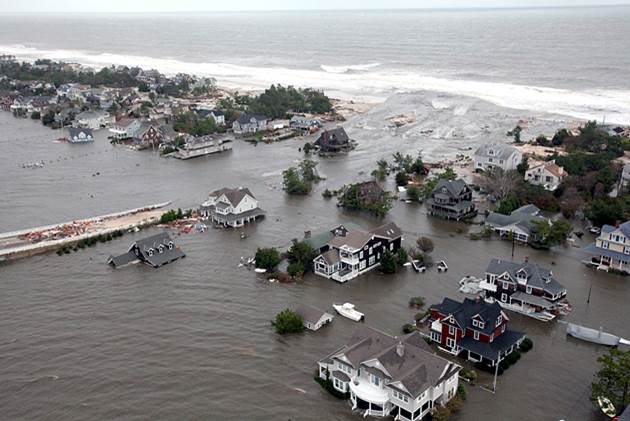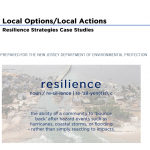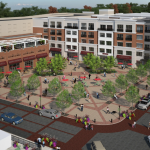New Jersey Future Blog
Is Route 1 a Street … or a Road?
January 11th, 2012 by Tim Evans
What’s the difference between a street and a road? Many of us use these terms interchangeably to denote any linear stretch of pavement designed for use by cars. But recognizing the distinction can mean the difference between good and efficient planning and a dysfunctional waste of public resources.
Charles Marohn at Strong Towns offers an interesting analysis of the difference between a street and a road:
- “Roads move people between places while streets provide a framework for capturing value within a place.”
- “If we want to maximize the value of a road, we eliminate anything that reduces the speed and efficiency of travel.”
- “If we want to maximize the value of a street, we design it in such a way that it supports an adjacent development pattern that is financially resilient, architecturally timeless and socially enduring.”
The Difficulty: Route 1 Is Trying To Be a Street and a Road
The distinction between streets and roads has practical application here in New Jersey, where Marohn’s description of the typical suburban roadway rings especially true: “Anytime you are traveling between 30 and 50 miles per hour, you are basically in an area that is too slow to be efficient yet too fast to provide a framework for capturing a productive rate of return.” In other words, the thoroughfare doesn’t add value to its surroundings by serving as the public space where all the elements of a traditional downtown can be accessed safely on foot; neither does it facilitate efficient movement of vehicles. The result, Marohn says, is that “[a]ll you have here is a bunch of people making inefficient local trips on a highway sized for high-speed, through traffic. That’s not a traffic problem. It’s a land use problem.”
This distinction is an important aspect of the discussion about whether and how to institute a bus rapid transit (BRT) system along the Route 1 corridor in Mercer and southern Middlesex counties. The municipalities that straddle Route 1 in central New Jersey have essentially been treating it as their Main Street, lining it with the land uses that formerly defined the traditional downtown: the innumerable strip malls offer local shopping and a multitude of low-rise office complexes act as employment centers. The fact that none of these destinations connect to each other via a pedestrian-friendly local street network has resulted in exactly the mismatch that Marohn laments: Residents use Route 1 for local trips, and the resulting traffic interferes with the trucks and other regional through traffic that is trying to use Route 1 as the shortest route from the New Jersey Turnpike in New Brunswick to I-95 or the Pennsylvania Turnpike.
In short, Route 1 has become schizophrenic, trying to serve both as a link in the regional highway system and as a Main Street—but a Main Street designed exclusively for cars.
Creating a BRT system that would link destinations along the corridor, using its own new right-of-way, offers the hope of diverting some local traffic off Route 1 and relocating the highway’s Main Street functions to a safer environment. But just running it through the parking lots of the existing chain of malls and office parks does not accommodate the needs of pedestrians and cyclists (and transit riders taking the new BRT), because such a system would be inaccessible to residential areas and would still traverse a primarily automotive landscape.
The Solution: Let Route 1 Be a Road, Shift Street-like Functions Elsewhere
Addressing traffic and pedestrian issues and the BRT question with this distinction in mind could bring some clarity to the decision-making about how and where to direct resources. Much needs to be done before Route 1 can function as the limited-access highway that regional traffic flows say it should be. In particular, a safe and inviting network of local streets on either side of Route 1, that encourage walking and slower vehicular speeds, would need to be established. (Canal Pointe Boulevard is a good example of just such a street.) Existing retail and office uses should then have their main entrances reoriented toward these local streets, so as to redirect local traffic away from Route 1. Ideally, new residential and commercial development would also be promoted immediately adjacent to proposed BRT stations, in order to create the kind of dense, varied and walkable nodes that a BRT system needs in order to thrive.
Less complicated—but perhaps more controversial—is the other precondition for Route 1 being able to disentangle its two distinct and conflicting roles: the elimination of access points to the highway (i.e., driveways, traffic signals and entrance roads), or the institution of a system of taxation for highway access. Restriction of access is not likely to be welcomed by the businesses along the highway that take their at-grade access for granted, but it is the key to reducing the constant vehicular acceleration, deceleration and turning maneuvers that compromise Route 1’s function as a link in the state highway system. Some steps in this direction have already been taken with the conversion into fully grade-separated interchanges of formerly signaled intersections such as those at Quakerbridge Road and Meadow Road.
Retrofitting Route 1 in Mercer County means focusing on its role as a link in the regional highway system while shifting its street-like functions elsewhere. The BRT proposal offers an opportunity to open the dialogue about how best to do this.
While Route 1 slowly resolves its identify crisis by shedding its street functions and becoming a road, there are also opposite examples. Along Route 440 in Jersey City the choice has been made to convert to a street that functions as a pedestrian-friendly boulevard. You can learn more about the Jersey City project and see other innovative examples at the 2012 Redevelopment Forum panel titled Complete Streets: How to Redevelop our Transportation Network.

















Tim-
While getting my Master’s in Infrastructure Planning @ NJIT, my design studio focused on Route 1 and proposed a BRT transit corridor.
If interested in more information, contact me.
Mike, thanks for the offer. We haven’t been directly involved in commenting on the specific alignment of a potential BRT, but if you’ve got an executive summary of your NJIT work, you might as well send it to me.
Mike,
I worked on the Princeton Dinky Segment of the BRT and would love to see more info. Thanks.
Don
de3100 hotmail
hotmail com
com
Canal Pointe was intended to run from Alexander Road to Quakerbridge Road/a local road. Was killed by no-growth advocates/the same people that complain about Rt 1 traffic. As Leo said in The Producers “no way out, no way out, …”.
Good thinking – but as long as people need to drive to reach a BRT stop, they will keep driving to whichever mall they aim at. And the malls etc. are too far apart to walk between.
Needed: more flyovers – and closure of lesser stop lights/access points to Rte 1, e.g. Black Horse Lane in North Brunswick, perhaps Carnegie Center Blvd. Widening Rt 1 to six lanes through S. Brunswick – or at least an added southbound lane as far as Finnegans Lane, since a lot of traffic turns off there.
Another comment via email:
I like your piece on US 1, including policy reccs. The trouble is that any road construction into and in the route 1 corridor is constrained by swamps, the D&R canal, and the NEC. BRT (with feeders) is almost our only way to move people through it.
Some interesting and pertinent news — NJDOT is going to be experimenting with removing left-turn moves at Washington Road and Harrison St. near Princeton. This would be one more step toward making Route 1 into a limited-access facility.
http://gmtma.wordpress.com/2012/01/19/next-week-nj-dot-meetings-on-route-1-jughandle-closures/
Seems that Rt. 1’s problem = rush hour traffic. Have studies shown that local trips during Rt. 1’s brutal rush hours are that large a contributor to the congestion? Who among local residents in their right mind plans multi-stop shopping trips along Rt. 1 during rush hour? T’would seem that only commuters forced to drive various lengths of Rt. 1 during rush hour may make local stops on the way home.
Where else in America have commercial strip roads successfully been converted into through highways?
Wouldn’t it be much easier to just build I-95 from 287 to 295, as planned, with 4 or 5 limited access connector roads between Rt. 1 and the new I-95 to suck a lot of the rush hour traffic off Rt. 1 and let Rt. 1 become the super commercial strip that it wants to be?
http://www.nycroads.com/roads/I-95_NJ/